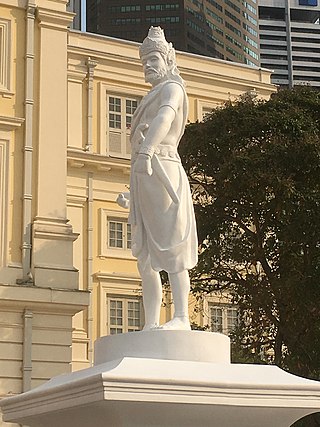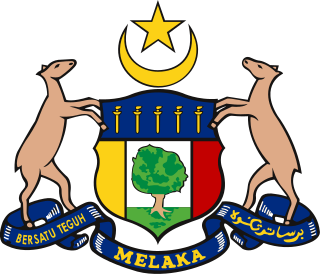Related Research Articles

The Malacca Sultanate was a Malay sultanate based in the modern-day state of Malacca, Malaysia. Conventional historical thesis marks c. 1400 as the founding year of the sultanate by King of Singapura, Parameswara, also known as Iskandar Shah, although earlier dates for its founding have been proposed. At the height of the sultanate's power in the 15th century, its capital grew into one of the most important transshipment ports of its time, with territory covering much of the Malay Peninsula, the Riau Islands and a significant portion of the northern coast of Sumatra in present-day Indonesia.

Temasek is an early recorded name of a settlement on the site of modern Singapore. The name appears in early Malay and Javanese literature, and it is also recorded in Yuan and Ming Chinese documents as Danmaxi. Two distinct settlements were recorded in Temasek – Long Ya Men and Ban Zu. The name is used in modern-day Singapore for national honours as well as institutions and corporations.

The Singapura is the smallest breed of cat, noted for its large eyes and ears, ticked coat, and blunt tail. Reportedly established from three "drain cats" imported from Singapore in the 1970s, it was later revealed that the cats were originally sent to Singapore from the United States before being exported back to the US. Investigations by the Cat Fanciers' Association (CFA) concluded that no wrongdoing had occurred and the Singapura kept its status as a natural breed.

Plaza Singapura is a contemporary shopping mall located along Orchard Road, Singapore, next to Dhoby Ghaut MRT station. The mall is managed by CapitaLand and owned by CapitaMall Trust. There are retail outlets over seven floors and two basements. The mall has a 752 lot seven-storey carpark at the rear of the building, and a two basement goods bay beneath it. The mall is popular with families, teenagers and young adults.

Masjid Omar Kampong Melaka is a mosque in Singapore, and is located at Keng Cheow Street in the Singapore River Planning Area, within the Central Area, Singapore's central business district.

Sang Nila Utama was a prince from Palembang and is the founder of the Kingdom of Singapura in 1299. His official title adopted upon his coronation was Sri Tri Buana, which can be translated as "Lord of Three Worlds"; the "Three Worlds" may refer to the three realms of the universe—the heaven of the gods, the world of humans, and the underworld of demons or his lordship over Java, Sumatra and Temasek/Singapura. This title is attested to elsewhere in Southeast Asia.

The early history of Singapore refers to its pre-colonial era before 1819, when the British East India Company led by Stamford Raffles established a trading settlement on the island and set in motion the history of modern Singapore.

The Coat of arms of Malacca resembles European heraldic designs, and descended from that of Malaysia and the Federated Malay States under British colonial rule.
Buyong Adil was a national historian of Malaysia and author of several books on the history of Malaysia. Buyong was a nickname given by his parents. He was also known as Cikgu Buyong. He would spend his later career working in the Dewan Bahasa dan Pustaka, a government regulating body that coordinates the use of the Malay language and Malay-language literature.
The names of Singapore include the various historical appellations as well as contemporary names and nicknames in different languages used to describe the island, city or country of Singapore. A number of different names have been given to the settlement or the island of Singapore all through history, the earliest record may have been from the 2nd century AD. Possible mentions of Pulau Ujong, the name for the island of Singapore, may be found in Chinese works, and it was also referred to as Temasek in Malay and Javanese literature. Sometime in the 14th century the name was changed to Singapura, which is now rendered as Singapore in English. Singapura means "Lion City" in Sanskrit, and Sang Nila Utama is usually credited with naming the city, although its actual origin is uncertain.

Parameswara, thought to be the same person named in the Malay Annals as Iskandar Shah, was the last king of Singapura and the founder of Malacca. According to the Malay Annals, he ruled Singapura from 1389 to 1398. The king fled the island kingdom after a Majapahit naval invasion in 1398 and founded his new stronghold on the mouth of Bertam river in 1402. Within decades, the new city grew rapidly to become the capital of the Malacca Sultanate. Portuguese accounts however, written a hundred years after his death, suggest he was from Palembang in Sumatra and usurped the throne of Singapura; he was driven out, either by the Siamese or the Majapahit, and went on to found Malacca.

Malacca, officially the Historic State of Malacca, is a state in Malaysia located in the southern region of the Malay Peninsula, facing the Strait of Malacca. The state is bordered by Negeri Sembilan to the north and west and Johor to the south. The exclave of Tanjung Tuan also borders Negeri Sembilan to the north. Its capital is Malacca City, which has been listed as a UNESCO World Heritage Site since 7 July 2008.

The Kingdom of Singapura was a Malay Hindu-Buddhist kingdom thought to have been established during the early history of Singapore upon its main island Temasek from 1299 until its fall sometime between 1396 and 1398. Conventional view marks c. 1299 as the founding year of the kingdom by Sang Nila Utama, whose father is Sang Sapurba, a semi-divine figure who according to legend is the ancestor of several Malay monarchs in the Malay World.
Paduka Sri Maharaja was the eldest son of Sri Rana Wikrama and the fourth Raja of Singapura. He was known as Damia Raja before his accession. According to Malay Annals, the reign of Sri Maharaja was marked with the event of swordfish ravaging the coast of Singapura. A young boy, Hang Nadim, thought of an ingenious solution to fend off the swordfish. The king was initially grateful, but felt increasingly threatened by the boy's intelligence, and ordered to have the boy executed; Hang Nadim's blood is said to have permanently stained the ground red, giving rise to the term "Tanah Merah" for Singapore's lateritic soils. In 1389, Sri Maharaja was succeeded by his son, Iskandar Shah, who is commonly identified with Parameswara, the founder of the Melaka Sultanate.
Sri Maharaja Sang Sapurba Paduka Sri Trimurti Tri Buana, (1245–1316) also known as Sri Nila Pahlawan, is a figure in the Malay Annals, highly revered as the legendary great ancestor of some of the major dynasties of the Malay world: Singapura, Malacca, Pahang, Johor, Perak, Kelantan, Terengganu and Siak Sri Indrapura. Legend has it that after his accession to Seguntang Hill with his two younger brothers, Sang Sapurba enters into a sacred covenant with Demang Lebar Daun the native ruler of Palembang, which laid the basis of the proper relationship between the Malay rulers and the subjects. The legendary sword believed to be carried by the king, the Cura Si Manjakini, is now formed part of the regalia of Perak Sultanate, whose rulers are said directly descended from the king. The details of Sang Sapurba stories are mainly composed of folklore and legends, and thus his historical existence is debated and disputed by modern historians. Even so, as De Jong argued in her article The Character of Malay Annals, the stories of the Malay Annals could have been realistically mixed with the historical figures and events.

Cura Si Manjakini is a sword mentioned in the Malay Annals as originally possessed by Sang Sapurba, the legendary ancestor of Malay kings. For hundreds of years, the sword became a symbol of a rightful sovereignty and power in Malay culture. It was first inherited by Sang Nila Utama the founder of Singapura, later by Parameswara the first ruler of Melaka Sultanate, and then by Muzaffar Syah I the first Sultan of Perak. The sword is now a part of the Perak Sultanate's official regalia.

Muhammad Hafizul Hakim bin Khairul Nizam Jothy is a Malaysian professional footballer who plays as a goalkeeper for second tier Malaysia M3 League club Harini FT.

Old Pahang Kingdom was a historical Malay polity centred in the Pahang region on the east coast of the Malay Peninsula. The polity appeared in foreign records from as early as the 5th century and at its height, covered much of modern state of Pahang and the entire southern part of the peninsula. Throughout its pre-Melakan history, Pahang was established as a mueang or naksat of some major regional Malayic mandalas including Langkasuka, Srivijaya and Ligor. Around the middle of the 15th century, it was brought into the orbit of Melaka Sultanate and subsequently established as a vassal Muslim Sultanate in 1470, following the coronation of the grandson of the former Maharaja as the first Sultan of Pahang.
Ahmad Khuzaimi bin Piee, nicknamed Jimmy, is a Malaysian professional footballer who plays as a defender for Malaysian Super League side Selangor and the Malaysia national team.